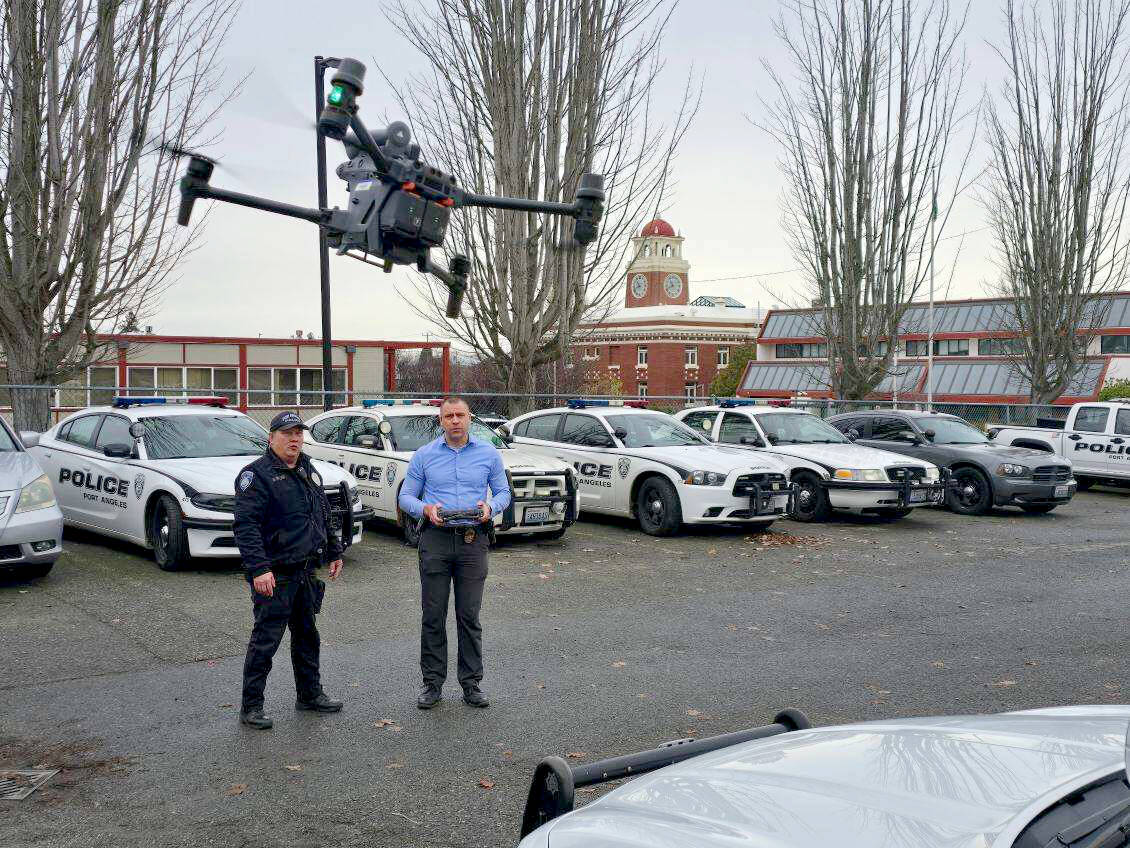PORT ANGELES — When a Navy Growler crashed near Mount Rainier in October, taking two crew members with it, search and rescue teams spent 24 hours combing the area with no success.
Then a team from the Jefferson County Sheriff Office (JSCO), and a drone, was called in for help.
“Within eight minutes of deploying [the drone], we were able to locate the crash site,” JSCO Detective Sgt. Derek Allen said.
Drones, or “force multipliers,” as Port Angeles Police Department (PAPD) police chief Brian Smith called them, are used by law enforcement officers across the United States in a variety of ways.
Different types of drones have different purposes.
“We kind of classify them as small, medium and large,” Allen said.
Small drones are primarily used indoors. They can break windows, map inside structures, communicate with suspects and more.
Sometimes, just the presence of a drone acts as deterrence. In a recent situation during which a suspect barricaded themselves in a building, law enforcement informed the suspect they were planning on sending a drone into the structure.
“As soon as he heard that was happening, he raised his hands and gave up,” said Guy Cranor, Clallam County Sheriff’s Office (CCSO) volunteer special deputy.
The large drones have a long list of uses, Allen said, including surveillance operations on drug buys, overhead watch during tactical operations, finding lost pets, assessing areas after natural disasters, locating and mapping wildland fires, pursuing fleeing subjects, code enforcement, and search and rescue.
In these situations, drones often are able to deescalate situations and provide buffers between law enforcement and potentially dangerous situations.
“Whatever we can do to lower the risk of injury … is something we’re going to do,” PAPD Sgt. Josh Powless said.
Medium drones are a blend between the small and large drones and often are used for mapping collisions or for short search and rescue operations. They can be used indoors, but they are sturdy enough to be flown outdoors and are easier to store in vehicles for quick deployment, Allen said.
“There’s almost nothing that you can think of that a drone could not, in some way, be used for these days,” Allen said.
Despite their multi-tool usefulness, Allen said drones will never replace the human component of law enforcement.
“They don’t have hands, they don’t have emotions, they don’t have any of the senses we have,” he said.
Drones also have limitations — the biggest one being battery life. Most have between 20 and 40 minutes of flight time before the batteries have to be switched out, PAPD Code Enforcement Officer Derek Miller said.
The technology also can quickly become outdated due to the fast pace of technological advancements.
“As quick as you buy the newest, biggest drone, the next day something comes out even better,” Allen said.
Federal policies also may shorten drones’ lifespan. Due to security concerns, CCSO Detective Seth Parker said the federal government is banning law enforcement from using grant money to purchase drones from the Chinese manufacturer Da-Jiange Innovations (DJI). There is a likelihood that future regulations may flat out ban DJI products for any government organizations, he added.
And, although drones can be helpful in a wide range of situations, there are some qualifications that must be met before they can be deployed, the biggest one being certification.
The 11 law enforcement and volunteer drone operators spread between Clallam and Jefferson counties had to go through Federal Aviation Administration training, which taught them how to navigate airspace.
Law enforcement officers also are usually required to obtain search warrants before a drone can enter or intentionally observe private spaces.
“Most of the time, we’re going to get one [a search warrant],” Powless said. “We’re constantly balancing new technology with privacy rights of people.”
Drones also can carry a wide range of price tags. Allen said the relatively inexpensive models are between $200 and $1,000, but one could easily spend over $25,000 on a drone. The additional bells and whistles also can quickly run up the price, Cranor said.
Most of the 12 drones owned across the JCSO, the CCSO and the PAPD were funded through grants or donations and, despite their price tags, they likely save law enforcement money in the long run.
“From a cost perspective, having a helicopter is really expensive,” PAPD Detective Trevor Dropp said. “[Drones] can do the same thing a helicopter would do.”
Although Parker said law enforcement began adopting drones in 2009, the JCSO, the CCSO and the PAPD all have had their drones for about five or six years.
During that time, Allen said the technology and capability evolved in ways he never thought possible.
In the future, Parker said he imagined drones will launch from a base location and arrive on scene before law enforcement, giving officers “real-time information for what is going on.”
However, Allen said drone technology is advancing so rapidly that “it’s hard to imagine where it could go.”
“I would say that’s almost an impossible thing to take a guess at,” he said.
________
Reporter Emma Maple can be reached by email at emma.maple@peninsuladailynews.com.

